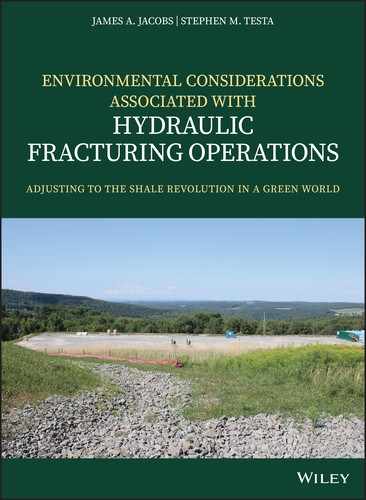16
Conclusions
Like mining, major construction or infrastructure development projects, horizontal drilling combined with hydraulic fracture stimulation operations, and oil and gas production are large‐scale industrial processes. When managed well, large‐scale industrial processes provide economic development, job opportunities, and new sources of cash flow for the landowners. When managed poorly without effective mitigation measures, large‐scale industrial processes have also been known to degrade the environment, lower availability and quality of water resources, negatively impact air quality, generate noise, odors, and dust, induce seismicity, and lower the overall quality of life for those living or working nearby. The energy revolution that has allowed for drilling and hydrocarbon production in areas that might contain dozens of contiguous counties has placed industrial processes squarely in the middle of agricultural, forested, or vacant lands. Some large urban and suburban areas overlie shale basins as well and will ultimately see unconventional oil and gas development, as seen in recent years encroaching on Broomfield, Colorado.
There are several points that can be made about this process:
- The first patent for artificial fracturing oil and gas reservoirs using torpedoes was issued in 1864, and in 1949, hydraulic fracturing was tested. Hydraulic fracturing is a stimulation process to enhance production, and by 1988, nearly one million oil and gas wells had undergone hydraulic fracture stimulation. Recent advances have allowed for the modern shale gas boom, albeit with environmental impacts that reflect the large scale use of this industrial process.
- Tight oil and shale gas extraction using horizontal drilling, hydraulic fracturing operations, and specialized chemical additives is pushing an economic boom in the United States as well as in many parts of the world, providing widespread, low‐cost fossil fuels.
- Although particular groundwater wells or local water resources may have been compromised from nearby HVHF operations, typically from surface spillage, there is only evidence of site‐specific non‐systematic environmental impacts to water resources in the United States from HVHF.
- US energy independence has been provided by hydraulic fracturing, and the United States is the global leader for the past few years of both liquid petroleum and natural gas production.
- If done properly with a focus on environmental stewardship, health protection, and worker safety, extraction of these unconventional resources can occur with limited impacts. If the industrial processes are done poorly, toxic chemicals will be released into the environment, potentially impacting health and safety of workers and nearby residents, damaging ecosystems, and degrading water and air resources.
- Accidents and contaminant releases will continue, but improvements with worker training, monitoring, equipment, procedures, and regulations should also occur. Although leaks and spills are a low percent compared to the number of activities performed and the volumes of chemicals transported, for the parties affected, the damages can be significant.
- Impacts to water resources include the risk of surface spills at the well site or through releases from pipelines, barges, railway tank cars, or tanker trucks. Improper disposal of drilling, hydraulic fracturing, and production wastes can also release toxins into the environment. Some of these risks to water resource impacts relate to proximity of historic and abandoned water, oil, and gas wells, which create subsurface conduits with inadequate or compromised well seals.
- Tight oil and shale gas have lower greenhouse gas footprints compared with some other fossil fuels, such as coal and tar sands, but their continued use produces greenhouse gases.
- Although lower in greenhouse gas emissions than bituminous coal, shale oil, and tar sands, tight oil and shale gas may well be slowing the adoption of renewable energy sources.
- Besides the petroleum hydrocarbons extracted during unconventional oil and gas production, large volumes of water and salts are coproduced in the brines. Besides the potential for developing water resources from the coproduced fluids, shale gas and oil naturally contain significant volumes of lithium, a primary element used in lithium electric vehicle (EV) batteries.
- The Bakken Formation, Marcellus Shale, Utica Shale, and similar source rock reservoirs will provide fossil energy resources for years or decades as long as they are economic, but they are unlikely to have the production longevity of conventional oil and gas fields like Kern River Oil Field (1899), Huntington Beach Oil Field (1920), Long Beach Oil Field (1921), and Santa Fe Springs Oil Field (1921) in southern California, the Permian Basin (1921) in Texas, or the Hugoton Gas Field in Kansas, Oklahoma, and Texas (1922).
- The oil and gas industry has historically cycled through periods of boom and bust, related to supply and demand, and the success of unconventional oil and gas production has led to low energy costs for consumers and low profit margins for producers with economic swings in oil‐ and gas‐producing regions.
- Until other more economic and environmentally friendly energy technologies supplant unconventional oil and gas production, these technologies will be with us for decades. Successful interactions between oil and gas operators, suppliers, contractors and the public require following best management practices, a focused attention on appropriate worker health and safety training, and accurate and safe waste management and disposal. The outreach process and developing public trust includes an attitude of cooperation and transparency fostered by interactive community communication and open disclosure of chemical additives and wastes used or generated during the hydraulic fracturing operations.
- Finally, with innovative thinking, some of the negative aspects of this energy revolution may create research and opportunities to develop new methods to recycle water and remove valuable salts from coproduced flowback fluids and brines, increase ways to recover a higher percent of oil and gas from conventional fields using better geologic models and technologies, capture methane and other air pollutants at the source, reduce operational footprints and habitat destruction, and improve quality of life in operating regions by understanding the related social, economic, and environmental concerns.
